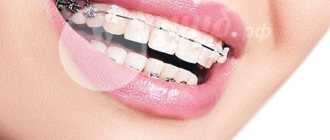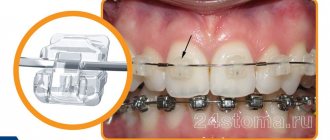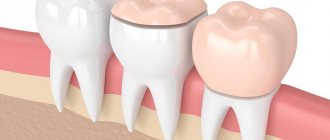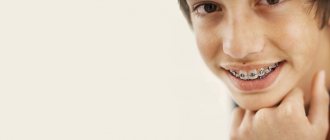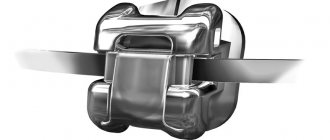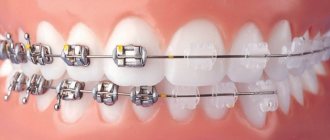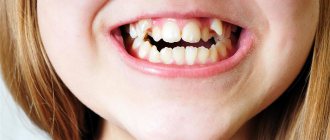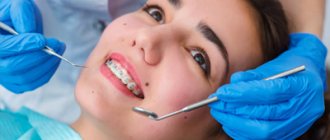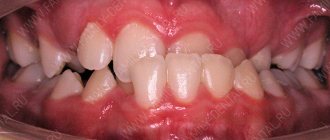From this article you will learn:
- How are braces installed?
- types of bracket systems – photos, reviews,
- how much does it cost to get braces in Moscow (for 2022).
Braces are a non-removable orthodontic structure designed to correct the incorrect position of a person’s teeth (correction of malocclusion). Braces are plates made of metal or ceramic that are glued to the outer or inner surfaces of the teeth. Each of the braces has a groove through which a metal arch with “shape memory” passes. The latter is designed to transfer forces to the teeth.
The orthodontist bends the metal arch before fixing it in braces (according to the curvature of the dentition), but under the influence of heat in the oral cavity, the arch with “shape memory” tends to return to its original “ideal” shape. As a result of the transfer of forces from the arch to the braces plates, the teeth receive the “forces” that are necessary to move them, which leads to the alignment of the dentition. The braces system for straightening teeth was first used in 1955.
Ceramic, lingual, metal braces: photos
The optimal period for installing braces for bite correction is from 8 to 14 years (at this age, the facial bones are still growing, which makes it easier for teeth to move). In addition, reviews of braces from orthodontists indicate that early initiation of treatment helps reduce the duration of treatment and facilitates the eruption of permanent teeth. As for adults, due to the cessation of growth of the facial bones, their teeth move longer than in children.
Metal braces on teeth - what are they?
Metal braces are non-removable orthodontic devices for correcting malocclusions and straightening the dentition. The main elements of this design are the locks, which are glued to the enamel of the teeth, as well as the arch connecting them. Ligature devices additionally use fasteners made of rubber or wire - ligatures that secure the arc in the grooves of the locks.
The most common metal for making braces is medical stainless steel. This is a strong, durable, inexpensive material, but the patient may experience an allergic reaction to it. As an alternative, manufacturers offer hypoallergenic alloys of nickel and titanium, gold, platinum or plating of precious metals.
The therapeutic effect is due to the physical properties of the metal from which the arc is made. After fixation in the locks, under the influence of body temperature, it strives to return to its original anatomically correct shape, gradually moving and aligning the teeth. Wearing the device for a year or two allows you to correct defects of any complexity.
The optimal period for this correction method is considered to be adolescence, starting from 12 years. At this time, the tissues of the maxillofacial apparatus are most pliable, so a lasting result is achieved quickly. You can install metal braces earlier - at 7-9 years old, if indicated. As a rule, children have partial “24” systems installed (on incisors and first molars).
More information about braces for children in our article.
Braces are a design for correcting malocclusion
Installing metal braces for adults is no less effective, although treatment may require more time.
Mandatory conditions for successful correction are regular visits to the orthodontist to adjust the structure, proper brushing of teeth, and long-term use of retainers or mouth guards after removal.
Popular models
You can consider the features of brace systems in more detail using the example of popular models.
STB
Lingual, ligature, metal system. Corrects even serious malocclusions. Treatment lasts a little longer than with more expensive devices.
photo: STB bracket system
The braces are only 1.5 mm thick. This size is achieved by reducing the bracket. Fixation occurs at a close distance from the root. Orthodontists do not recommend installing such a system if the teeth are very crowded.
DamonQ
Self-ligating (ligature-free) bract system from Ormco. Represents the latest model of the Damon line. The locks are so small that they look like rhinestones. Each bracket is equipped with a small cap, which, when closed, forms a tube for attaching the arch.
photo: Daimon Q bracket system
The load due to which bone stimulation is carried out is not so great as to disrupt the blood supply to the periodontium. However, it is sufficient to effectively move teeth.
Victory
The peculiarity of the series is that the braces have a high adhesion force to the teeth.
photo: Victory bracket system
The base of the bracket consists of 80 cells that are woven into a network. It follows the anatomical structure of the crown , thereby ensuring the best fit to the enamel. The wings on the premolar are slightly spaced from the tooth and slightly expanded.
Alexander
Wings of such designs allow you to change the level of rotation (displacement). The alloys from which locks are made include chromium, iron, aluminum and copper.
photo: Alexander bracket system
Thanks to this, the orthodontic structure is highly durable and not subject to oxidation . Quick achievement of results is ensured by the peculiarities of load distribution.
In Ovation R
photo: In Ovation R bracket system
Unique metal design. Interactive wire latch reduces brace installation time. The base is made of triple mesh. The special spring properties of the arches speed up the treatment process.
Types of metal braces
More than a hundred years have passed since the appearance of the first orthodontic device similar to a modern one for correcting malocclusion, during which the design was constantly improved. Today, foreign and domestic manufacturers offer different device options, each of which has its own design features, advantages, and disadvantages.
Metal vestibular braces
This is the name given to braces systems that are attached to the outer surface of the teeth. Their advantages include:
- high efficiency - treatment takes 1-2 years (six months for minor defects), pathologies of any complexity can be corrected;
- short adaptation period - no more than 2 weeks;
- quick installation, easy maintenance;
- affordable prices.
The main disadvantage of the vestibular metal brace system is its low aesthetic characteristics. Locks and arches made of metal, especially titanium, are clearly visible on the teeth, so patients often experience psychological discomfort and are embarrassed to smile and talk. However, only external metal braces can minimize the treatment period and correct very complex defects.
The location of the device on the front surface of the teeth sometimes leads to another complication - injury to the structural elements of the mucous membrane of the cheeks and tongue. Installing more compact models of locks or using special silicone wax will help avoid this.
Lingual metal braces
They are considered braces systems for perfectionists or public people who do not want to advertise the fact of orthodontic treatment. Lingual metal braces are attached to the inner surface of the teeth, facing the tongue, and are therefore completely invisible to others. This is their only advantage over vestibular devices, and there are several disadvantages:
- increase in treatment time by 1.5-2 times;
- problems with diction for several weeks after installation;
- risk of tongue injury;
- difficulties in care;
- impossibility of use in difficult cases (with severe crowding of teeth);
- high price.
The last point may be decisive when choosing: lingual structures will cost 8-10 times more than vestibular ones.
Difference Between Lingual and Vestibular Braces
Metal ligature braces
Classic orthodontic treatment, they are distinguished by the presence of a separate fastening element - ligature. The latter is a wire or elastic rubber ring with which the arc is fixed in the grooves of the locks.
Metal ligature braces, due to their rigid fastening, are more effective, reducing treatment time, and also cost less than any analogues. However, there are a number of disadvantages that are important to consider when choosing:
- low aesthetic characteristics - massive locks with ligatures are very noticeable on the teeth;
- high risk of injury to the mucous membrane due to the large size and high profile of braces;
- the need for monthly visits to the orthodontist to adjust the system and replace ligatures.
However, ligature devices are in high demand due to their high efficiency combined with low prices. In addition, manufacturers, in order to improve the appearance of their products, produce multi-colored, shaped rubber fasteners.
Self-ligating metal braces
A special feature of ligature-free brace systems is the presence of built-in clips with locks. This design has several advantages:
- quick installation - the doctor needs significantly less time to fix the arc in the locks;
- rapid adaptation – self-ligating systems have a gentler effect on the teeth, so adaptation is almost painless;
- comfortable wearing - locks with clips have a streamlined shape with smoothed corners, a low profile, so the oral mucosa is less likely to be injured;
- reduction in the number and duration of visits to the doctor - a specialist requires less time to adjust the system, and visiting the orthodontist is enough once every two months.
The higher cost of self-ligating metal brace systems is compensated by the comfort of their use, and design features have little effect on treatment time.
Mini metal braces
This category includes ligature structures with reduced clasps - their surface area is 25-30% lower than that of standard analogues. At the same time, the reliability of fixation on the enamel is not reduced: manufacturers make the supporting surface of the lock in relief and equip it with a reinforcing mesh.
Due to their small dimensions, Mini brace systems are more comfortable to use, as they do not injure the mucous membranes and look quite aesthetically pleasing. The disadvantages include the need for regular monthly visits to the doctor, characteristic of ligature devices.
Plastic
One of the options that was popular in the past. But with the development of other systems, it became not the most preferable. Plastic braces are used together with rubber rings - ligatures, since metal locks with grooves for the arch are not installed in them. The fact that the material is less durable than metal or ceramics does not play a big role: breaking the bracket itself is quite difficult, especially if you follow the nutritional rules. However, they do have disadvantages.
Plastic braces with colorless ligatures
pros
- Transparent or white - look more aesthetically pleasing than metal.
- You can use bright colored ligatures, but then the meaning of transparent braces is lost.
- Affordable price.
Minuses
- They work more slowly than the self-ligating system, since over time the effect of the ligatures weakens and they hold the arch less well. The arc “slides” slower than in metal grooves.
- The braces and ligatures themselves turn yellow over time due to coloring foods (tea, coffee, berries, spices).
Alternative to metal braces
If you are not satisfied with the aesthetic or functional properties of metal bracket systems, you can choose an analogue from a different material. The table shows the main characteristics of different types of orthodontic structures.
| Metal | Ceramic | Sapphire | |
| Duration of treatment, effectiveness | Minimum, from six months to 2 years. Allows you to correct defects of any complexity | From one and a half years, not suitable for correction of complex pathologies | From 1.5 years, not used to treat complex cases |
| Durability, practicality | Durable and not stained with food coloring | The ceramics of the locks are fragile and require careful handling | Artificial sapphire crystals are fragile |
| Aesthetics | Low | High | Very high |
| Comfort | Possible injuries to the mucous membrane, pain during the adaptation period | The likelihood of injury is low, addiction is easy | Low trauma, quick adaptation |
| Safety | Medical steel can provoke an allergic reaction due to individual intolerance | Ceramics are hypoallergenic | Hypoallergenic |
| Minimum cost without installation (for 1 jaw), in rubles | 14000 | 25000 | 40000 |
Ceramic products are also called metal-ceramic, since the locks are made of ceramics, and the power arc is made of steel.
Advantages and disadvantages of ligature systems
To make more aesthetically pleasing modern braces, ceramics, gold or artificial sapphire crystals are used, which can be ligated or unligated. The main advantages of having a ligature:
- It is easier for a specialist to control the treatment process by changing the level of exposure to the bracket system. This achieves a fairly quick and effective correction of anomalies in the placement of teeth, expansion or narrowing of the jaw.
- If a child wears a fixed braces with a ligature, for young patients there is a wide variety of interesting colored rubber bands for fixing the arch.
- For ceramic plates, you can choose transparent or white ligatures, replacing them according to the degree of color change. As a rule, coloring substances contained in food cause the elastic elements to acquire a yellowish tint after two weeks.
- Replacing decorative ligatures with metal ones allows the doctor to influence the speed of tooth movement at the end of treatment. This technique helps to quickly achieve the desired effect without injury - at this point the teeth achieve good mobility.
- A reliable ligature system is successfully used to correct dental growth pathologies at any age, and has the most affordable price among brace systems.
- Compared to other types of orthodontic appliances, ligature braces require less time to achieve the desired result.
Ligatures serve to firmly connect the brackets, so the high-strength structure can withstand any tension and provide excellent control of tooth rotation. However, the old bulky design of braces with ligatures has several significant disadvantages:
- The patient is forced to constantly visit the doctor.
- The adaptation period to ligature braces is slightly longer.
- The pain is quite pronounced and occurs every time after replacing the ligature with a new element.
- Ligatures for braces made of artificial sapphires and ceramics can quickly be stained, requiring frequent replacement.
- Orthodontic appliances require very careful oral hygiene after every meal.
The presence of a ligature system makes the design more noticeable. There are lingual braces that are attached to the inner surface of the tooth enamel, but their use in combination with ligatures negatively affects the quality of diction.
Which metal braces are better?
Modern metal braces are the best option for quick bite correction. In our clinic, the patient can choose any model, focusing on the duration of treatment, ease of wearing and his own budget.
Metal braces Damon Q
The most popular brand of metal self-ligating braces, produced by Ormco (USA). Damon Q is a ligature-free device of the passive type, in which the arc is not rigidly fixed in the lock, but can move in it. Thanks to this feature, the adaptation process is painless, correction is performed in the most natural way possible. Other advantages of the design include:
- patented SpinTek mechanism, ensuring compactness, strength, and wear resistance of locks;
- installation does not require the removal of dental units; the device also makes it possible to free up space for dystopic teeth;
- ease of use - low risk of injury to the mucous membrane, neutral appearance, ease of care;
- hypoallergenic metal alloy;
- reducing the frequency of visits to the orthodontist to once every 2 months.
The listed advantages have little effect on the cost of products. The cost of installation per jaw is only 1.5 times higher than that of more massive, difficult to maintain ligature structures.
3M Unitek
The products of the American company have been used in dental practice since the middle of the last century. The manufacturer is constantly improving its developments, releasing new models of fixed orthodontic appliances to the market. Among the advantages and features of 3M Unitek metal products are:
- variety – you can choose classic vestibular, invisible lingual (Incognito), ligature or self-ligating systems;
- small sizes and smoothed corners of the locks, which improves the appearance of the structure and reduces the likelihood of injuries to the mucous membrane;
- adhesive (glue) pre-applied to the surface of the braces – this reduces installation time and eliminates the orthodontist’s mistakes in the process. An insufficient amount of adhesive leads to the formation of voids between tooth enamel and metal and the development of caries.
3M Unitek are made of stainless steel, nickel-titanium alloy. Vestibular structures are inexpensive and allow you to correct your bite quickly.
Vestibular system 3M Unitek
Ortho Technology
Another American company that has been producing fixed orthodontic appliances since 1991. Metal structures are presented in two versions - ligature Marquis and self-ligating Lotus.
The classic model with ligatures is reliable, allows you to correct the bite quickly (on average, within a year), and is inexpensive. At the same time, the locks have a low profile, so the adaptation time is reduced, and the likelihood of injury to the soft tissues of the oral cavity is reduced.
A non-ligature brace system requires longer treatment (from one and a half years), but is less noticeable than a ligature brace system due to the small size of the clasps. The neutral appearance, the ability to visit the orthodontist less frequently, and quick and painless adaptation justify the higher cost of the self-ligating structure.
Pilot
Metal vestibular ligature braces produced in Russia. Their advantages include:
- reliability - locks and arches are made of metal using powder pressing, which increases the strength of the structure;
- short treatment time – the design has a more intensive effect on the dentition, effectively correcting malocclusions of any complexity;
- low prices, distinguishing the products of the Russian manufacturer from imported analogues.
A significant drawback of Pilot braces is their massiveness. Wide locks with a high profile look unsightly and can injure the mucous membrane of the cheeks and lips. In addition, allergies sometimes occur to the metal of the product, and the company does not offer alternative alloy options.
Metal braces American Orthodontics
An American company supplies metal ligature devices of the Master series to the Russian market. The systems are made of medical steel, have several modifications, and are not much more expensive than domestic ones.
In addition to the standard advantages of metal braces (strength, quick bite correction, reasonable prices), American Orthodontics designs have enhanced aesthetic properties. For example, the size of locks in the Mini Master model is reduced by 25% compared to standard options. This has a positive effect on appearance, but does not reduce efficiency.
Differences between ligature braces and non-ligature braces
For non-ligature systems
, as the name suggests, there are no ligatures - the arch is not rigidly attached to the bracket, it can move within the space inside the lock. The absence of ligatures eliminates the need to adjust them, so you need to visit the orthodontist almost half as often. However, it should also be taken into account that a lower friction force leads to results more slowly, so wearing ligature braces allows you to get the correct bite faster. Sometimes they are the only option for correcting the position of teeth - gross anomalies will not respond to other methods.
Features of metal braces
Metal bracket systems are in deserved demand due to their combination of affordability and high efficiency. They can be used to correct malocclusion in patients of any age, starting from 7 years old. When choosing between metal and other materials, you should take into account all the positive and negative characteristics of iron structures.
Pros of metal braces
The undoubted advantages of metal fixed orthodontic appliances include:
- high efficiency - treatment lasts from six months to 2 (in especially severe cases - up to 3) years;
- a wide range of indications – metal braces are suitable for correcting malocclusions and dentition of any complexity;
- increased strength - steel, nickel-titanium alloy are resistant to mechanical loads and wear;
- possibility of installation on the inner surface of teeth (lingual models);
- affordable prices for vestibular type systems.
Cons of metal braces
Along with the listed advantages, steel structures have a number of imperfections:
- painful period of adaptation;
- high risk of damage to the mucous membranes of the lips and cheeks (for ligature products of standard sizes);
- low aesthetic properties;
- the need to visit the orthodontist at least once a month;
- possible allergic reaction to steel.
To eliminate the negative consequences of treatment, specialists at the YuliSTOM clinic use modern models made of hypoallergenic alloys with low-profile locks.
You should visit the orthodontist at least once a month
Indications and contraindications
Installation of metal braces helps correct the following pathologies of the development of the dentofacial apparatus:
- any type of malocclusion;
- crowded teeth;
- dystopia – displacement of the dental unit forward or backward;
- correction of the dentition in the absence of one or more teeth;
- wide interdental spaces - diastemas.
The list of contraindications to treatment with braces includes:
- significant damage to the periodontium and teeth;
- oncological diseases;
- diabetes;
- neuroendocrine, immune, neuropsychiatric pathologies;
- lack of a large number of dental units;
- anomalies in the development of the skeletal system;
- bruxism (teeth grinding during sleep).
How is treatment with metal braces performed?
Fixed orthodontic appliances apply constant pressure to the teeth, causing them to gradually move into the desired position. The arch plays a significant role in this process: at first it repeats the irregular shape of the teeth, but tends to return to its original position, thanks to which it smoothly corrects the bite. After each correction, the doctor changes the archwire to a thicker one to increase the pressure.
Let's look at why metal braces straighten teeth faster. The main quality of a metal system is its strength, and it does not really matter what metal is used in the braces. Due to the force of pressure, the teeth move faster and the treatment period is reduced. If the patient is faced with a choice between sapphire or metal braces, he must understand: although the sapphire design looks attractive, it will take a little longer to wear due to the fragility of the material.
So how long do you wear metal braces? Orthodontists call the average treatment period 1.5 - 2 years, but everything, of course, depends on the clinical case. The minimum period is 1 year for mild crowding of teeth, the maximum is about 3 years.
Installation of metal braces
The process of dentition correction begins with a visit to the dental clinic for a consultation with an orthodontist. At the initial appointment, the specialist performs an examination, agrees with the patient on the type of system to be installed, and issues directions for diagnostic procedures - orthopantomogram, teleroentgenogram.
At the preparatory stage, complete sanitation of the oral cavity (dental and periodontal treatment) and hygienic professional cleaning are required, and impressions are taken. Based on the research results, a treatment plan is drawn up.
The installation itself is carried out sequentially in several stages:
- Treatment of tooth enamel with a preparation that increases the adhesive properties of the glue.
- Fixing locks on the surface of teeth using a direct or indirect method. In the first case, each of them is glued separately, in the second, all the locks are simultaneously transferred to the jaw using a special mouth guard.
- Removing excess glue.
- Fixing the arc, securing it in the grooves using ligatures or built-in clips.
Upon completion of the manipulations, the doctor gives recommendations for care and sets a date for the next visit to activate the system. There are no fundamental differences in installing braces for children and adults.
When is their installation scheduled?
Experts identify a number of key indications for installing a traditional corrective model of the device. Below we have listed the main ones:
- malocclusion is an incorrect position of the jaws relative to each other when they close, which often leads to pathological wear of teeth, periodontal diseases, problems with breathing and chewing food. In this case, installing the device is a mandatory measure, and not a solution to an aesthetic problem,
- the need to prepare for subsequent treatment - prosthetics and implantation,
- malocclusion due to the loss of one or more teeth,
- the need to correct the dental arch, incorrect position of individual units, crowding or too wide interdental spaces.
Malocclusion is an indication for the use of braces.
If you do not begin timely treatment of the existing dental defects, the patient may have problems with diction and chewing food, which will inevitably lead to certain disturbances in the gastrointestinal tract. There is also a risk of pathological abrasion of the enamel, the appearance of microcracks on it and other unpleasant consequences. Therefore, if a problem is diagnosed, it must be solved, and this must be done as quickly as possible - in children and adolescents, such anomalies can be corrected much more easily and quickly than in adults.
How long do you wear metal braces and how do you care for them?
The average duration of treatment is from 1 to 2 years, the first results appear after 3 months. In some cases, when the defects are minor, it is enough to use metal braces for only six months, but complex pathologies may require wearing for 3 years.
Depending on the degree of responsibility of the patient, the correction period initially determined by the doctor may decrease or increase. Proper care, compliance with medical recommendations, and timely visits to the clinic speed up treatment. The list of mandatory care measures includes:
- daily thorough cleaning of teeth, braces after meals;
- the use of special cleaning devices - mono-beam, V-shaped toothbrushes, brushes;
- additional use of dental floss, irrigator, rinses;
- regular professional cleaning as recommended by the orthodontist.
The listed measures will help maintain the integrity of tooth enamel and avoid the development of carious processes. In addition to hygienic care, it is necessary to adhere to the rules of nutrition: do not eat too cold or hot foods, drinks, and do not eat hard, sticky foods. You need to clean your teeth carefully: excessive force can damage the structural elements.
Braces need to be cared for carefully using special devices.
How to brush teeth with ligature devices
When treated with devices with ligatures, hygiene becomes more complicated.
To thoroughly clean your teeth and orthodontic structures after meals, use mono-beam toothbrushes, brushes, dental floss and an irrigator. Plaque accumulates between the ligatures and braces, and food remains get stuck. With poor oral hygiene, the bacterial film is tightly attached to the surface of the teeth and braces. Bacteria destroy enamel and cause tooth decay. When treated with self-ligating models, you spend less time on hygiene procedures due to the small size of the braces and the polished metal or ceramic surface. Vertical, circular and sweeping movements of the toothbrush cleanse the structure and enamel of plaque and food debris.
treatment with self-ligating Damon Clear
How to remove metal braces
Metal braces are removed after complete treatment. The procedure consists of several stages:
- a power arc is released from the locks;
- each bracket is removed individually with special forceps;
- soft polishing of tooth enamel is performed to remove residual orthodontic adhesive;
- teeth are coated with a remineralizing composition;
- Retainers are installed.
The last manipulation is necessary to prevent tooth displacement. Wire structures are fixed on the inner surface of the dentition; they need to be worn for the same amount of time as the correction lasted, or longer. You can replace fixed retainers with a mouthguard worn at night.
Stages of orthodontic treatment
- Leveling stage. Nickel-titanium arches of circular cross-section tilt the teeth in the direction of the forces, begin to correct the rotation and angulation of the teeth, and the correct shape of the dentition is formed.
- Basic mechanics stage. On rectangular nickel-titanium, TMA or steel arches, the teeth are moved body-wise into the position of correct occlusion. The correct position is controlled in three planes: torque, angulation and rotation. If necessary, the orthodontist installs miniscrews and additional elements: springs, bite braces, buttons, intermaxillary elastics.
- Retention period. To stabilize the treatment results, the doctor fixes a metal retainer on the lingual surface of the incisors and canines of the upper and lower jaw. In addition to the permanent retainer, the patient wears a retention mouth guard at night.
orthodontic retainer
How much are
Prices for metal braces in St. Petersburg vary widely. The final cost of treatment is determined by the type of bracket system, the amount of work required for installation, subsequent maintenance, and removal. Unplanned expenses may arise if the locks become unstuck or the arc breaks. The table shows the current minimum prices for equipment and services.
| Name | Cost of OT, rub. |
| Ligature system | 17000 |
| Mini | 14000 |
| Lingual braces | 80000 |
| Self-ligating bracket system | 21000 |
| Direct fixation | 3000 |
| Indirect fixation | 6000 |
| Taking an impression | 600 |
| Comprehensive diagnostics | 2500 |
| System activation | 2000 |
| Re-fixing the bracket | 450 |
| Replacing the lock | 1400 |
| Removing the bracket system | 3360 |
The price is for one jaw, without installation.
Device installation steps
The procedure for fixing metal braces takes about 1-2 hours. Lingual metal systems require longer installation times.
On a note! The first time after installing any type of system, regardless of materials, adaptation will be required. The feeling of pain and inability to close the staples with your lips, discomfort when chewing food can last up to several weeks. Such phenomena are considered normal and should not be feared. If necessary, your doctor may prescribe pain medications.
In general, the treatment process consists of the following stages:
- initial consultation with a specialist,
- diagnostics: an x-ray of the entire jaw system is taken to determine the position of the tooth roots, the condition of the jaw bone, and identify hidden dental diseases,
- preparatory stage: braces are installed only on previously treated teeth and gums. Therefore, you will first need to get rid of caries and undergo oral sanitation, removing hard deposits and plaque using ultrasound and enamel polishing,
- Taking impressions: based on them, a model of the jaw is created. It is used to work through the entire treatment process,
- installation of braces: the plates are fixed with a special composite glue, which hardens under the influence of a light lamp. Then they are connected with a metal arc, and ligatures are installed if necessary.
The photo shows the process of installing braces.
Afterwards, the doctor will definitely explain to the patient how to care for the braces and what to do if they become unstuck or damaged. In the process of addiction, our body, or rather even the brain, perceives the orthodontic apparatus as a “foreign” body. Therefore, it will take about 2-3 weeks until you get used to the installed systems.
On a note! If there is acute discomfort, you can use special wax or silicone. The products are applied to the protruding elements of the bracket system and smooth out sharp edges. In this way you can protect yourself from damage to the mucous membranes.
You will have to visit your orthodontist throughout the entire treatment period, and the frequency of these visits will largely depend on how often the archwire needs to be changed. If there are ligature systems - once a month to replace elastic bands and once every 2-3 months. to update the arcs. When wearing self-regulating systems, it will be enough to see a doctor once every 2-3 months. But closer to the end of treatment, you will have to visit the orthodontist more often - at least every month. As for how long you will have to wear braces in general, everything is individual. The less pronounced the pathology, the faster the desired result will be achieved. On average, the duration of wearing metal systems varies from six months to one and a half years. By the way, with self-ligating structures, treatment takes on average 20% less time than with ligature ones.
After removing braces, unfortunately, there is no need to relax. A period of retention begins, during which a special splint, mouth guard or retainer is fixed on the teeth. These are devices that are designed to consolidate the results of long-term treatment. Otherwise, the teeth will very quickly return to their original state.
FAQ
1. Can there be an allergy to the material of the products? Yes, sometimes there is an allergic reaction to steel structures. In this case, they are replaced with titanium, gold, and platinum.
2. If the lock suddenly comes unglued, how quickly do you need to put it back in place? The sooner the better, since defects negatively affect the effectiveness of the structure (in a few days the tooth can return to its original position).
3. What to do if the structure severely injures the mucous membrane? Orthodontists recommend using a special wax that protects soft tissues from damage.
4. What can cause the arc to break?
From eating hard foods, due to injury, from brushing your teeth too vigorously. Moscow metro station Zvezdnaya, Danube Avenue, 23
Adaptation
The adaptation period is one of the most difficult for the patient. Possible problems with diction, toothaches and a feeling of rubbing of the oral mucosa.
Unpleasant sensations appear when chewing food, as well as when clenching the jaws.
The duration of this stage does not exceed a week. If the pain does not go away within 2 weeks, you should contact an orthodontist.
The problem of injury to the mucous membrane is solved by placing special wax on parts of the structure that have a rubbing effect.
Diction disorders occur more often when installing lingual structures. Speech is restored quite quickly without medical intervention.
While wearing braces, you should refrain from eating foods that can damage the structure.
Self-ligating and ligature braces: what is the difference
When ligature-free products first entered the dental market, they were accompanied by aggressive marketing and confident PR from manufacturers. This increased sales, but some exaggeration of the benefits made the professional audience and interested clients skeptical. For a long time there were debates about quality, efficiency and convenience. Research was carried out. The bottom line is that the analysis showed which of the advantages of self-ligating braces are true and which are fiction.
Ligature and non-ligature braces - similarities and differences:
